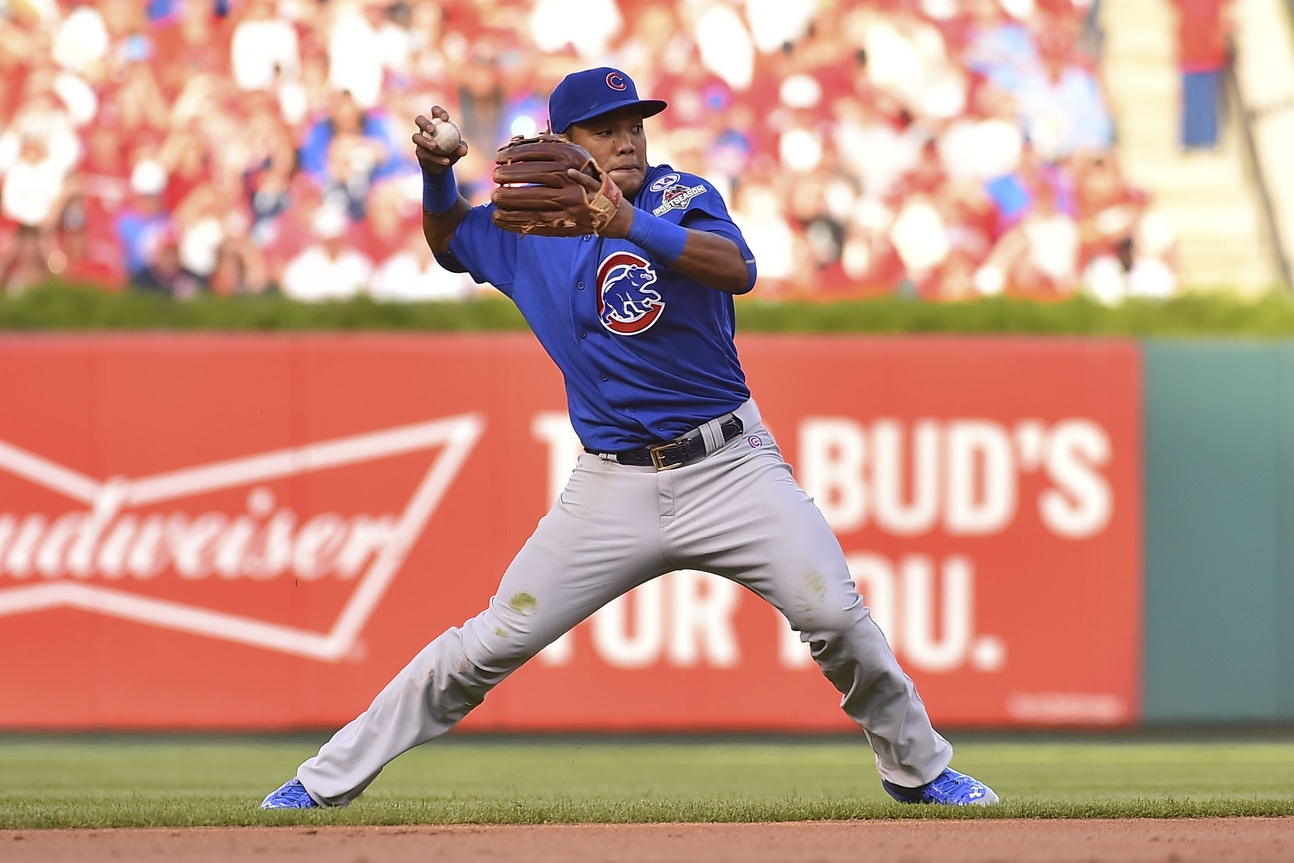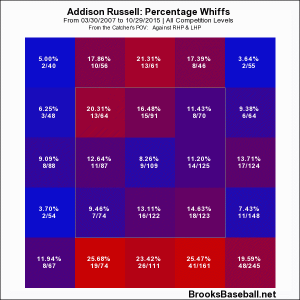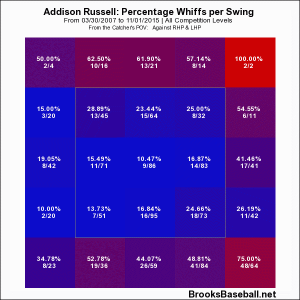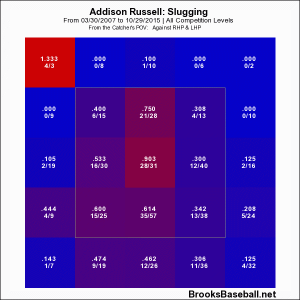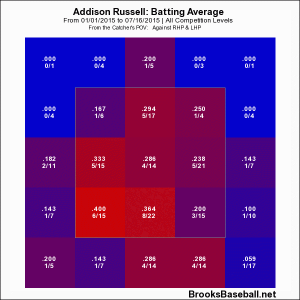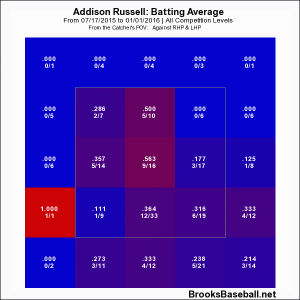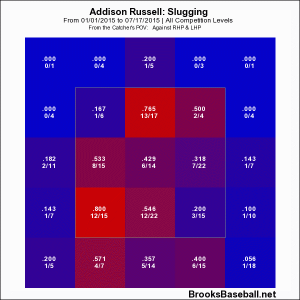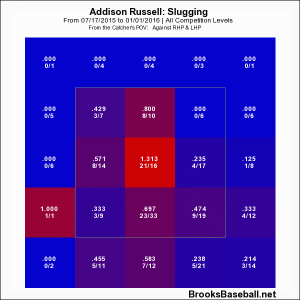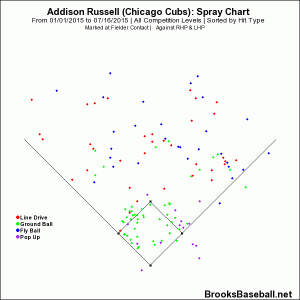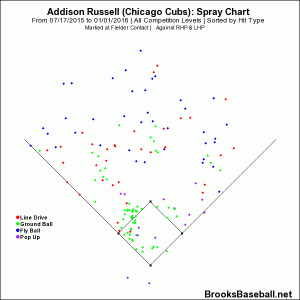Addison Russell
Position: Shortstop/Second Base
2015 Stats: .242/.307/.389, .252 TAv, 1.57 WARP
Year in Review: As he laced a flyball off the base of the left-field wall, made his way around second, found that extra gear, and sprung himself airborne as he dove into third base, Addison Russell could have hardly imagined it would be his last moment on the field for the Cubs in 2015. But, much like the Cubs’ own season, which shone bright for nearly six months before being extinguished without fanfare, Russell’s 2015 came to an end with a hamstring injury, a potently short denouement to a remarkable year.
In a marquee 2015 for rookies across the majors, the Cubs’ 21-year-old, middle-infield phenom flew slightly under the radar. The injury that kept him out of the NLCS will make it easy for many to forget the value he provided for a very good team, but the fact is Russell’s debut season featured a host of highlights at the plate and in the field.
Defensively, there are few better infielders in the league. After three and a half months of spectacular glove work at the keystone, Joe Maddon shifted Russell across the bag to shortstop, where he shined even brighter. Both the defensive metrics and the eye test bear witness to his outstanding range and strong arm: he posted 3.2 Fielding Runs above Average, a mark that would be eighth in the majors among second basemen and 12th among shortstops. That solid ranking is somewhat corroborated by his ranking third among shortstops in Fangraphs’ Defensive Runs above Average, only behind leather luminaries Andrelton Simmons and Brandon Crawford. Necessary caveats about defensive metrics aside, Russell is clearly a top-notch fielder in all aspects, as evidenced by plays like these:
Two easily overlooked facets of Russell’s game deserve particular praise: His smoothness handling double play turns at second base—from either side of the bag—and his quickness in applying tags on potential base stealers. He and Starlin Castro were a formidable double play combo in both configurations, and Russell swiftly adapted the footwork of a second baseman when he plied his craft on that side of the bag. He possesses incredibly quick hands, a boon when turning double plays and when fielding less-than-impeccable and oftentimes rushed throws from Cubs’ catchers. Consensus was that Russell would be a good defender, but he’s flashed potential to be elite.
Where Russell stands to improve most is at the plate. He managed a modest 13 home runs, a good total for a rookie middle infielder (non-Carlos Correa division), walked at an eight percent rate (about average), and struck out at a high 28.5 percent clip. I wrote in July of Russell’s midseason adjustments—mechanically and with his approach—which helped him cut down briefly on strikeouts and up his walk rate, but his end-of-season strikeout and walk rates match those he possessed at the time of that piece, indicating only a temporary respite from Ks.
Russell will never wield the bat with the panache of Kris Bryant or Kyle Schwarber, but he performed admirably at the difficult task of hitting ninth in a National League lineup.
Looking Ahead: Russell is no longer the youngest player in the NL as he was upon his April debut, but he’s still only 21. His combination of outstanding maturity and work ethic make him a good bet to break out in 2016 as an impact player, but even if his hitting remains staid, he’ll be a cog in the Cubs’ lineup and infield.
There are a few specific difficulties for Russell at the plate that contributed to his below average 2015 totals. He has a tendency to swing and miss at a lot of pitches just below the zone where umpires are calling more and more strikes. His raw whiff rates at pitches just below the zone sat around 25 percent, and his whiffs as a percentage of swings in those areas neared 50 percent.
Making more contact with those pitches might not actually be beneficial—that would likely result in more grounders, and Russell would likely do well to hit more flyballs to tap into his latent power—but if he can begin to curtail whiffs by cutting down on swings, he might be able to up his walk rate and lower his strikeout rate.
A corollary to Russell’s swing-and-miss tendencies is his inability to hit pitches on the outer third of the plate with authority. He can mash pitches on the inner parts, which is what produced those 13 home runs, but he’s ice cold when it comes to anything on the outside corner.
Holistically, he struggled to do anything with those outside pitches. Russell made some serious mechanical changes in July, as Sahadev Sharma discussed at the time. When we split Russell’s season into pre- and post-All-Star Break, we get an even starker portrait in how he hit pitches on the outer third. Here are his batting average and slugging percentage profiles by zone, as well as his spray chart, split at the break:
While closing his stance, implementing a leg kick, and better linking his timing between his feet and hands helped him increase his power to the tune of eight second half home runs, it seems to have made him more vulnerable to outside pitches. His spray charts tell an interesting story, as well: in the second half, his groundballs became more closely clustered on the left side of the infield, indicating a higher tendency to pull the ball, but he began hitting the ball farther in general. He hit inner and middle-third pitches with more authority, but began to roll over pitches on the outside corner.
To Russell and hitting coach John Mallee, this was an acceptable trade off. However, as Rian Watt relayed in his analysis of Theo Epstein’s postseason comments and Sharma went into greater detail on, the Cubs seem poised to emphasize (to some extent) contact ability this offseason. As a young player whose hitting approach is more malleable than most, I wouldn’t be surprised to see Russell work hard on making solid contact with that outside pitch. Putting good swings on pitches over the outer third and figuring out the knee-high strike are difficult tasks, but they appear to be key to Russell’s growth as a hitter.
Except to the harshest of observers, there are few things to identify as weaknesses in Russell’s defensive game. Expect him to contend for Gold Gloves, Fielding Bible awards, Nobel Prizes in Defense, etc., for the foreseeable future. (Yes, that’s really all I have to say about that).
Conclusion: Players’ development and maturation is very rarely linear; this is a theme that I think underpins a lot of the writing here at BP Wrigleyville, as we contend with the novelty of a team whose success is largely contingent on the development of young hitters. The sharpness of emotions felt as the Cubs’ season came to an abrupt end at the hands of the similarly young Mets was birthed from some level of doubt that the Cubs, as well constructed as they are, could make it back to the NLCS soon. Just ask the Rangers or Nationals about false assumptions of linear progression.
And so, bear in mind that Russell, much like the Cubs writ large, might not take the leap forward that we hope for in 2016. Regardless, the broad-shouldered young man will likely be ensconced at shortstop for the Cubs for many years, and he should continue to provide impeccable defense. The offensive question marks remain, but even if Russell stagnates and is a .252 True Average hitter for his career, he won’t be an automatic out at the bottom of the order. In the best case scenario, Russell cuts his strikeout rate and works with Mallee to develop an approach that covers more parts of the strike zone.
No one could have been sure how Russell, like the team whose jersey he dons every day, would play in 2015. It was hardly a foregone conclusion that he would even see a major-league diamond this year. And like the Cubs, he’s already good. The question is, will he be great?
Lead photo courtesy of Jasen Vinlove-USA TODAY Sports
